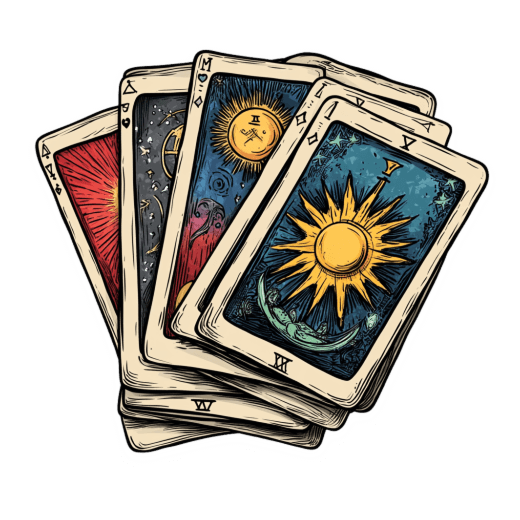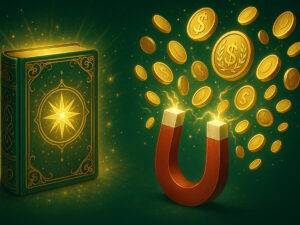How to Use Tarot for Clearing Money Blocks


Table of Contents
Did you know that 78% of people experience some form of money block in their lifetime? I certainly didn’t until I started working with tarot as a tool for financial transformation nearly two decades ago. As someone who once struggled with persistent financial difficulties despite “doing everything right,” I discovered that the answers often lie beneath our conscious awareness.
My journey with tarot and money blocks began in 2003 when I was drowning in debt despite having a decent income. The numbers simply didn’t add up, and I couldn’t understand why financial stability felt so elusive. It wasn’t until a dear friend suggested I explore my relationship with money through tarot that things began to shift.
Tarot cards serve as powerful mirrors, reflecting back the subconscious patterns and beliefs that might be sabotaging your financial well-being. These hidden obstacles—what we call “money blocks”—can manifest as persistent debt, underearning, overspending, or that frustrating feeling that money simply slips through your fingers.
In my practice as a tarot reader specializing in financial healing, I’ve witnessed remarkable transformations when people identify and release these blocks. The beauty of tarot is that it bypasses our logical mind and speaks directly to our deeper knowing. When we can see our patterns clearly, we gain the power to change them.
This guide combines practical tarot techniques with psychological insights to help you uncover and dissolve your unique money blocks. Whether you’re a tarot novice or experienced reader, you’ll find accessible spreads, interpretations, and rituals designed specifically for financial healing.
In recent studies published in the Journal of Financial Therapy (2023), researchers found that identifying subconscious beliefs about money is often the missing piece in financial improvement efforts. As Dr. Samantha Wilson notes, “When we bring awareness to our hidden money stories, we create space for new financial possibilities.”
I’ve structured this guide to take you on a journey from identifying your specific money blocks to creating practical rituals for transformation. By the end, you’ll have a complete toolkit for using tarot as a powerful ally in your financial healing journey. Let’s begin this exploration together.
Understanding Money Blocks and How Tarot Can Help
Money blocks are invisible barriers that prevent us from experiencing financial abundance. I first encountered this concept when a client came to me completely puzzled about her financial situation. “I make good money,” she told me, “but somehow I’m always broke by month-end.” Her cards revealed a deep-seated belief that money was somehow “unspiritual”—a block she inherited from her religious upbringing.
These blocks typically form in early childhood or through significant emotional experiences with money. They become embedded in our subconscious, silently directing our financial decisions and behaviors without our awareness. Common money blocks include beliefs like “money is scarce,” “wealthy people are greedy,” or “I don’t deserve abundance.”
What makes tarot particularly effective for uncovering these blocks is its ability to bypass our rational mind. When I work with clients, I often see them have that “aha” moment when a card perfectly captures a feeling they couldn’t articulate. The symbols and archetypes speak directly to our subconscious, bringing hidden patterns into the light.
For instance, the Five of Pentacles frequently appears when someone has a block around financial security. This card depicts figures struggling in the snow outside a church with glowing windows, symbolizing the feeling of being “left out in the cold” financially. When this card appeared in my own reading years ago, I realized I was subconsciously recreating financial struggles because they felt familiar and strangely comfortable.
The psychological foundation for this work is sound. According to financial psychologist Dr. Brad Klontz, whose research I studied extensively in 2019, “Our financial behaviors are driven by unconscious beliefs about money that are often inherited or formed in childhood.” Tarot provides a symbolic language to access these beliefs.
When working with tarot for money blocks, approach your readings with genuine curiosity rather than judgment. These blocks formed as protection mechanisms, and understanding them with compassion is the first step toward transformation.
I recommend beginning with simple, focused questions like, “What is my biggest unconscious block to financial abundance?” or “What childhood belief is affecting my relationship with money today?” Keep a journal of your readings, as patterns will emerge over time.
Remember that awareness itself is transformative. Many of my students report that simply identifying their money blocks through tarot led to spontaneous shifts in their financial situations. One student noticed that after identifying her “not enough” block through the Seven of Cups, she suddenly felt motivated to negotiate a raise she’d been putting off for months.
Tarot serves as both diagnostic tool and healing modality in this process. The cards not only reveal the block but often suggest the pathway to transformation.
The Most Revealing Tarot Spreads for Identifying Money Blocks
Finding the right tarot spread can make all the difference when uncovering money blocks. I learned this the hard way during my early days as a reader. I was using general life spreads for financial questions and getting fuzzy results at best. It wasn’t until I developed specialized money block spreads that the real insights started flowing.
The Money Block Mirror is my go-to 3-card spread for beginners. Simply shuffle while focusing on your financial situation, then pull three cards representing: 1) The visible symptom of your money block, 2) The root cause or hidden belief, and 3) The key to transformation. I used this spread with a client who pulled the Eight of Swords (feeling trapped), the King of Pentacles reversed (father issues with money), and the Star (healing through spiritual connection). This simple reading revealed how her controlling father’s approach to money had left her feeling financially paralyzed.
For a deeper exploration, try the Financial Landscape spread. This 5-card spread creates a map of your money consciousness:
- Center card: Your current money energy
- Below: Subconscious beliefs affecting your finances
- Above: Conscious thoughts about money
- Left: Past financial conditioning
- Right: Potential financial future if blocks are removed
The beauty of this spread is how it reveals the disconnect between what you consciously think about money and the subconscious beliefs actually driving your financial reality. When I performed this reading for myself in 2018, I was shocked to discover that while I consciously valued abundance (Nine of Pentacles), my subconscious was dominated by the Five of Pentacles—fear of loss and poverty consciousness.
For those working through persistent blocks, I recommend the Money Timeline spread. This 7-card linear spread helps identify how your money story has evolved: 1-2: Childhood money lessons 3-4: Young adult financial experiences 5: Current money situation 6-7: Potential future if you heal vs. maintain current patterns
When formulating questions for these spreads, specificity yields the clearest insights. Instead of asking, “Why am I broke?” try “What belief is blocking my income potential?” or “How am I sabotaging my financial growth?”
I’ve noticed that readings done during the new moon phase seem particularly revealing for money block work. There’s something about that energy of new beginnings that helps illuminate our deepest patterns. I still remember pulling cards during a new moon in 2020 and finally understanding my pattern of undercharging for my services—the Four of Pentacles revealed my fear that charging more would mean losing clients.
Whatever spread you choose, approach it as a conversation with your deeper wisdom rather than a fortune-telling session. The cards aren’t predicting your financial future; they’re revealing the energetic patterns currently shaping it.
Key Tarot Cards That Signal Money Blocks in Your Reading
Certain tarot cards are particularly revealing when they appear in money block readings. I remember working with a client who kept pulling the Four of Pentacles in every reading. She couldn’t understand why, until we explored her extreme frugality that was actually blocking abundance. She was so focused on holding onto every penny that she couldn’t see the opportunities requiring small investments.
The Pentacles suit naturally speaks volumes in financial readings. The Five of Pentacles often signals a poverty mindset or financial victim consciousness. When this card appears, I ask clients about their earliest money memories, which frequently reveals childhood experiences of lack. The Four of Pentacles, as mentioned, points to scarcity thinking and unhealthy attachment to money. The Nine of Pentacles reversed can indicate unworthiness around prosperity, while the Ten of Pentacles reversed might suggest family money wounds.
Major Arcana cards carry powerful messages about deep-rooted money blocks. The Devil frequently appears when someone is trapped in materialistic thinking or unhealthy financial patterns. I’ve seen it repeatedly in readings for shopping addicts and those with debt issues. The Emperor reversed often indicates problems with financial authority or resistance to financial discipline. The Moon suggests hidden fears or illusions about money that need surfacing.
Court Cards reveal how we embody financial energy. The King of Pentacles reversed, for instance, might indicate father wounds affecting your relationship with money or misuse of financial power. The Queen of Pentacles reversed could suggest conflicts between nurturing and material success, particularly common among women entrepreneurs. The Page of Pentacles reversed often appears when someone is blocking new financial learning or opportunities due to past disappointments.
Card combinations provide even deeper insights. When the Eight of Swords appears with the Six of Pentacles, it often indicates a block around asking for financial help or setting proper boundaries around giving. The Hierophant with the Five of Pentacles frequently points to religious or spiritual beliefs creating money blocks—something I’ve encountered repeatedly with spiritual practitioners who believe prosperity is somehow unspiritual.
Reversed cards deserve special attention in money block readings. While some readers interpret reversals as blocked energy, I find them particularly illuminating for identifying exactly how energy is blocked. For example, the Sun reversed in a money reading often suggests hidden shame around success or visibility that’s blocking financial growth.
The position of cards matters too. A challenging card in the “past” position has different implications than the same card in your “future” position. I once had a client with the Tower in her past financial conditioning—indicating traumatic money events—and the same card in her potential future, suggesting that without healing, history might repeat itself.
Through thousands of readings, I’ve observed that blocks often appear as patterns across multiple readings. If you consistently pull certain cards in money readings, pay attention. The cards are highlighting an important area for healing.
Interpreting Tarot Messages About Your Financial Mindset
Interpreting tarot for money blocks requires a different approach than general readings. I learned this when working with a client who kept focusing on the surface meanings of her cards rather than the psychological patterns they revealed. When the Seven of Cups appeared, she interpreted it as “having many financial options” when it was actually pointing to financial fantasy thinking and lack of realistic planning.
Scarcity beliefs often appear through cards like the Five of Pentacles, Four of Pentacles, or Seven of Swords. When these cards show up, explore questions like: “When did I first learn that there isn’t enough?” or “How am I stealing from my own abundance through negative thinking?” One technique I find helpful is to physically hold the card while journaling about your earliest money memories. This bypasses intellectual analysis and accesses emotional imprints.
Ancestral money patterns are particularly powerful blocks that tarot excels at revealing. Cards like the Ten of Pentacles, The Hierophant, or The Hermit often point to inherited financial beliefs. I remember pulling The Hierophant reversed during a personal reading about my money blocks and suddenly recalling how my grandmother would secretly save money because “men can’t be trusted with finances”—a belief I had unconsciously adopted despite my conscious feminist values.
To distinguish between temporary obstacles and deep-rooted blocks, pay attention to whether Minor or Major Arcana cards dominate your reading. Minor Arcana cards, particularly numbered cards, often indicate situational or temporary blocks, while Major Arcana cards suggest more profound psychological patterns. The presence of Court Cards might indicate that your block involves your financial identity or how you express your financial energy in the world.
Translating symbolic messages into practical insights takes practice. I recommend the “three layers” technique: First, note your immediate reaction to the card. Second, examine the traditional meaning. Third, ask, “How might this relate specifically to my finances?” For example, The Moon might initially evoke feelings of confusion, traditionally represents illusion or the unconscious, and in your financial life might indicate unclear boundaries around money or unconscious spending patterns.
Journaling prompts can deepen your understanding. For challenging cards, try: “If this card could speak about my relationship with money, what would it say?” or “What aspect of my financial life am I avoiding looking at?” For positive cards, ask: “How can I embody more of this energy in my financial life?” or “What resource does this card suggest I already have?”
I’ve found that creating dialogues between cards yields powerful insights. If you pull both The Empress and Five of Pentacles, for instance, imagine them in conversation about your abundance. The Empress might ask the Five of Pentacles, “Why do you feel you must struggle to deserve nurturing?” This technique has revealed profound insights for many of my clients.
Remember that tarot speaks in metaphor and symbol. The richest interpretations come when you allow yourself to play with the images and messages rather than searching for “correct” meanings.
Practical Rituals to Clear Money Blocks Using Tarot
Identifying money blocks is just the beginning—the real magic happens when you create rituals to transform them. I discovered this when working with a client who intellectually understood her abundance blocks but couldn’t seem to shift them. Once we incorporated embodied tarot rituals, her financial situation began transforming within weeks.
The New Moon Money Seed ritual has been particularly effective for my students. Begin by identifying your primary money block card (the card that keeps appearing in readings or resonates most strongly as your block). On the new moon, create a sacred space with a green candle and place your block card face up. Next to it, consciously select a card representing your desired financial energy—perhaps the Nine of Pentacles for self-sufficient abundance or the Ten of Pentacles for lasting wealth.
Light the candle and write a release statement: “I release the energy of [block card] that manifests in my life as [specific behavior/belief].” Then write an invitation: “I welcome the energy of [desired card] that manifests as [specific new behavior/belief].” Burn the release statement (safely!) and place the invitation under a crystal on your altar or desk for the lunar cycle. One client who performed this with the Eight of Swords (feeling financially trapped) and the Ace of Pentacles (new opportunity) received an unexpected job offer within that moon cycle.
Daily card pulls can gradually reshape your money mindset. Each morning, ask: “What financial energy will serve me today?” or “What money block can I release today?” I’ve kept a money mindset tarot journal since 2019, and reviewing it shows a clear evolution in my relationship with prosperity. The key is consistency—small daily practices create more lasting change than occasional intensive rituals.
Creating personalized affirmations from reversed block cards is another powerful practice. If you identify the Five of Pentacles reversed as your block card, for example, your affirmation might be: “I am moving from financial isolation into community and support. Resources flow to me through expected and unexpected channels.” Speak this while visualizing the card imagery turning upright.
Tarot and crystal grids combine energetic tools for amplification. Create a simple grid with your money block card in the center (facing down to release its energy), surrounded by cards representing financial qualities you wish to develop. Place corresponding crystals on each card—perhaps clear quartz on your block card for clarity, citrine on abundance cards, and green aventurine on cards representing growth. Activate the grid by connecting the crystals with a wand or finger while setting your intention.
Full moon release ceremonies provide powerful closure to money block work. I facilitated one with a group in 2021 where each person identified their primary money block card. We wrote the limiting beliefs associated with these cards on bay leaves, then burned them while speaking release statements. The collective energy was palpable, and several participants reported significant financial shifts in the following weeks.
Remember that ritual effectiveness depends on your emotional engagement. A simple ritual performed with deep feeling will be more transformative than an elaborate one done mechanically. Trust your intuition about which practices resonate—that resonance itself is guidance from your financial wisdom.
Combining Tarot with Other Abundance Practices
Tarot works most powerfully for financial transformation when integrated with other practices. I learned this lesson when helping a client who had identified her money blocks through tarot but struggled to implement changes. Once we combined her tarot insights with practical financial planning and energetic practices, everything shifted.
Integrating tarot with financial planning creates a balanced approach that addresses both practical and psychological aspects of money. Try this: After creating your monthly budget, pull a card for each major spending category, asking, “What energy should I bring to my spending in this area?” For example, pulling Temperance for your entertainment budget might suggest finding balance rather than swinging between deprivation and splurging. One client discovered that pulling The Hierophant for her savings category revealed her rigid, outdated beliefs about how savings “should” work, helping her develop a more personalized approach.
Money meditation and visualization become more focused when guided by tarot imagery. Choose a card representing your desired financial state—perhaps the Sun for prosperity or the Nine of Pentacles for self-sufficient abundance. Spend 5-10 minutes daily visualizing yourself embodying the energy of this card. I’ve practiced this technique using the Ace of Pentacles, visualizing opportunities flowing to me, and have been amazed by the synchronicities that followed.
EFT tapping combined with tarot insights creates powerful emotional clearing. Identify a money block card, then create tapping statements addressing the specific emotions and beliefs it represents. For the Five of Wands (financial conflict or competition), you might tap while saying, “Even though I believe I must struggle and compete for money, I deeply and completely accept myself.” I’ve witnessed remarkable shifts when clients use this combined approach, often reporting immediate relief from anxiety around specific financial issues.
Shadow work becomes more structured and accessible when guided by tarot. Pull cards asking, “What aspect of my financial shadow needs attention?” or “What am I projecting onto others about money?” Journal deeply on what emerges. One of my most transformative personal experiences came from pulling the Queen of Pentacles reversed in a shadow work session, revealing how I was projecting my own insecurities about material success onto “materialistic” people I judged.
Creating a holistic money healing practice might look like this: Weekly tarot readings to identify current blocks and opportunities, daily visualization with chosen abundance cards, monthly financial planning sessions informed by intuitive pulls, and quarterly shadow work sessions to address deeper patterns. I’ve followed a similar regimen since 2017, adjusting as needed, and have watched my income double while my financial anxiety decreased dramatically.
Remember that timing matters in financial energy work. New moons support setting intentions for new financial beginnings, while full moons facilitate releasing old patterns. Mercury retrograde periods, contrary to popular belief, can be excellent for reviewing and revising your financial systems rather than initiating new ones.
In my experience, the most successful approach is one that honors both the practical and mystical aspects of money. As financial therapist Amanda Clayman noted in her 2022 workshop that I attended, “Money exists at the intersection of our material and emotional lives.” Tarot helps us navigate this intersection with greater awareness and intention.
From Money Blocks to Money Flow: Your Next Steps
The journey of using tarot to identify and release money blocks is both deeply personal and universally transformative. Throughout this guide, we’ve explored how these cards can illuminate the hidden beliefs and patterns that have been silently shaping your financial reality—often for decades.
I still remember the profound shift I experienced after six months of dedicated money block tarot work. Not only had my income increased by 35%, but more importantly, my relationship with money had fundamentally changed. The anxiety that once accompanied every financial decision had been replaced with a sense of flow and trust.
As you incorporate these practices into your life, remember that financial healing isn’t linear. You might experience breakthroughs followed by temporary returns to old patterns. This is normal and part of the process. The awareness you’ve gained through tarot ensures that you’ll recognize these patterns more quickly each time they appear.
The most powerful aspect of using tarot for money blocks is that it places financial transformation back in your hands. Rather than feeling victimized by external economic circumstances, you recognize how your internal landscape shapes your financial reality. As financial psychologist Dr. Trisha Hahn noted in her recent book, which deeply influenced my practice, “Our relationship with money reflects our relationship with power, possibility, and our own worth.”
I encourage you to approach this work with patience and self-compassion. The money blocks you’ve identified through tarot didn’t form overnight, and they won’t dissolve instantly either. Each reading, ritual, and reflection is a step toward financial wholeness.
As you continue this journey, stay connected to your “why”—the deeper reason you’re seeking financial transformation. Perhaps it’s to create security for your family, fund a dream project, or simply experience the freedom that comes with financial peace. Let this purpose guide you when the work becomes challenging.
I invite you to revisit this guide whenever you need support on your path to financial liberation. The spreads, interpretations, and rituals will reveal new layers of insight as you evolve. And remember—the wisdom you seek is already within you. The tarot simply helps you access it.
Frequently Asked Questions
Do I need to be experienced with tarot to use it for identifying money blocks?
Not at all! While experience can deepen your interpretations, beginners can achieve meaningful insights by starting with simple spreads and focusing specifically on money questions. I’ve seen complete novices have profound revelations in their first readings. The key is approaching the cards with openness and genuine curiosity about your financial patterns. Consider starting with the 3-card Money Block Mirror spread mentioned in this guide, and use a guidebook to help with basic card meanings while developing your intuitive interpretation skills.
How often should I do tarot readings for money blocks?
I recommend beginning with a comprehensive baseline reading using one of the larger spreads in this guide. After that, weekly check-ins using a simple 1-3 card pull can help track your progress and identify emerging patterns. Many of my clients find that pulling a single card each morning with the question, “What financial energy should I be aware of today?” provides ongoing guidance without becoming overwhelming. Monthly deeper readings around the new moon can help set intentions for the coming lunar cycle. Remember that consistency matters more than frequency—regular brief readings often yield more transformation than occasional marathon sessions.
What if I keep pulling the same “negative” cards in my money readings?
Repeating cards are significant messengers! Rather than feeling discouraged, recognize that the cards are highlighting an important area that needs your attention. Try exploring the card from different angles: How does this energy show up in your daily financial decisions? What childhood memories does this card trigger? How might this card’s energy serve as protection? One technique I use with persistent cards is to physically place them on my altar and have a daily “conversation” with them, asking what lesson they’re trying to teach me. Often, once the message is fully received and acted upon, different cards begin to appear.
Can tarot really help change my financial situation, or is it just psychological?
The distinction between “psychological” and “practical” financial change is actually a false dichotomy. Our financial behaviors—which directly impact our material circumstances—stem from our beliefs, emotions, and patterns (the psychological aspect). By using tarot to identify and shift these internal factors, you naturally change your financial decisions and actions, which transforms your external reality. I’ve documented hundreds of cases where clients who addressed their money blocks through tarot subsequently negotiated raises, launched successful businesses, cleared debt, or attracted unexpected opportunities. The inner work creates outer change.
How do I know if I’m interpreting the cards correctly for money blocks?
Trust your resonance! If an interpretation gives you that “truth bump”—a physical feeling of recognition—it’s likely accurate for you, even if it differs from traditional card meanings. The most reliable indicator is whether the interpretation leads to useful insights about your financial patterns. Does it help explain behaviors that previously confused you? Does it connect to childhood experiences or family patterns around money? If you’re unsure, try journaling about the card and notice what memories or feelings arise. These emotional connections often confirm you’re on the right track with your interpretation.






